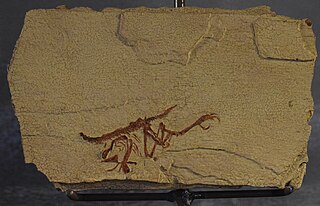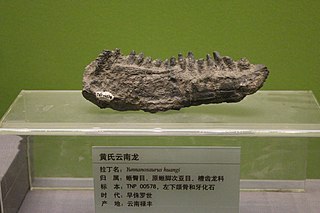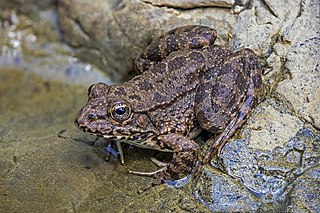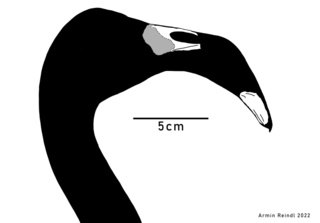
Obdurodon is a genus of extinct platypus-like Australian monotreme which lived from the Late Oligocene to the Late Miocene. Three species have been described in the genus, the type species Obdurodon insignis, plus Obdurodon dicksoni and Obdurodon tharalkooschild. The species appeared much like their modern day relative the platypus, except adults retained their molar teeth, and unlike the platypus, which forages on the lakebed, they may have foraged in the water column or surface.

Rails are a large, cosmopolitan family of small- to medium-sized terrestrial and/or semi-amphibious birds. The family exhibits considerable diversity in its forms, and includes such ubiquitous species as the crakes, coots, and gallinule; other rail species are extremely rare or endangered. Many are associated with wetland habitats, some being semi-aquatic like waterfowl, but many more are wading birds or shorebirds. The ideal rail habitats are marsh areas, including rice paddies, and flooded fields or open forest. They are especially fond of dense vegetation for nesting. The rail family is found in every terrestrial habitat with the exception of dry desert, polar or freezing regions, and alpine areas. Members of Rallidae occur on every continent except Antarctica. Numerous unique island species are known.

Rana is a genus of frogs commonly known as the Holarctic true frogs, pond frogs or brown frogs. Members of this genus are found through much of Eurasia and western North America. Many other genera were formerly included here. These true frogs are usually largish species characterized by their slim waists and wrinkled skin; many have thin ridges running along their backs, but they generally lack "warts" as in typical toads. They are excellent jumpers due to their long, slender legs. The typical webbing found on their hind feet allows for easy movement through water. Coloration is mostly greens and browns above, with darker and yellowish spots.

Iberomesornis is a monotypic genus of enantiornithine bird of the Cretaceous of Spain.

Metailurus is a genus of saber-toothed cat in the family Felidae, and belonging to the tribe Metailurini, which occurred in North America, Eurasia and Africa from the Miocene to the Middle Pleistocene.

Yunnanosaurus is an extinct genus of sauropodomorph dinosaur that lived approximately 199 to 183 million years ago in what is now the Yunnan Province, in China, for which it was named. Yunnanosaurus was a large sized, moderately-built, ground-dwelling, quadrupedal herbivore, that could also walk bipedally, and ranged in size from 7 meters (23 feet) long and 2 m (6.5 ft) high to 4 m (13 ft) high in the largest species.

Amphicyon is an extinct genus of large carnivorans belonging to the family Amphicyonidae, subfamily Amphicyoninae, from the Miocene epoch. Members of this family received their vernacular name for possessing bear-like and dog-like features. They ranged over North America, Europe, Asia, and Africa.
The Shanwang National Geology Park is located in central Shandong province, People's Republic of China, about 22 kilometres (14 mi) from Linqu County. It has an area of about 13 square kilometres (5.0 sq mi). The Park is well known for the fossil bearing Shanwang Formations diatomitic deposits, one of only a few such deposits in China. It is also well known for its volcanic topography.

Dendrorhynchoides was a genus of anurognathid pterosaur containing only the holotype species D. curvidentatus that is known from the Middle Jurassic Tiaojishan Formation of Qinglong, northern Hebei Province, China.
Paleontology or palaeontology is the study of prehistoric life forms on Earth through the examination of plant and animal fossils. This includes the study of body fossils, tracks (ichnites), burrows, cast-off parts, fossilised feces (coprolites), palynomorphs and chemical residues. Because humans have encountered fossils for millennia, paleontology has a long history both before and after becoming formalized as a science. This article records significant discoveries and events related to paleontology that occurred or were published in the year 1989.

Ontocetus is an extinct genus of walrus, an aquatic carnivoran of the family Odobenidae, endemic to coastal regions of the southern North Sea and the southeastern coastal regions of the U.S. during the Miocene-Pleistocene. It lived from 13.6 mya—300,000 years ago, existing for approximately 13.3 million years.
Macropelobates is an extinct genus of prehistoric frogs. It was described by Gladwyn Kingsley Noble based on material from Oligocene of Mongolia.

Pelophylax is a genus of true frogs widespread in Eurasia, with a few species ranging into northern Africa. This genus was erected by Leopold Fitzinger in 1843 to accommodate the green frogs of the Old World, which he considered distinct from the brown pond frogs of Carl Linnaeus' genus Rana.

Ursavus is an extinct genus of bear that existed in North America, Europe, and Asia during the Miocene period, about 23–5.3 million years ago (Mya), existing for roughly 17.7 million years. The genus apparently dispersed from Asia into North America about 20 Mya, becoming the earliest member of the subfamily Ursinae in the New World. Qiu points out that if a questionable 29 million-year-old specimen of Ursavus reported in North America is validated, Ursavus may have evolved in North America and dispersed westward into Asia. The higher number of fossils in Europe grading toward eastern Asia make the westward dispersal unlikely.

Gustafsonia is an extinct genus of carnivoran belonging to the family Amphicyonidae. The type species, Gustafsonia cognita, was described in 1986 by Eric Paul Gustafson, who originally interpreted it as a miacid and named it Miacis cognitus. It was subsequently considered to be the only species of the diverse genus Miacis that belonged to the crown-group Carnivora, within the Caniformia, and it was ultimately assigned to the family Amphicyonidae. The type specimen or holotype was discovered in Reeve's bonebed, western Texas, in the Chambers Tuff Formation in 1986. The University of Texas holds this specimen. It is the only confirmed fossil of this species.
Dolichoderus lacinius is an extinct species of Miocene ant in the genus Dolichoderus. Described by Zhang in 1989, fossils of a queen specimen were found in China.

Ballusia is a genus of small bear from the Early Miocene epoch, about 20.5-18 million years ago. Fossil remains attributed to the genus have been uncovered in Europe (Poland) and Asia. The genus Ballusia was established in 1998 on the basis of different fossils originally classified as various species of the genera Ursavus and Hemicyon, with B. elmensis as the type species. The exact relationship of Ballusia to "true" bears are not yet fully understood: many palaeontologists have classified it as a primitive member of Ursinae, but its known skeletal elements have some features in common with the extinct bear subfamily Hemicyoninae. Because of this, some researchers refer Ballusia as "Ursidae incertae sedis". Ginsburg and Morales regarded B. elmenensis as ancestral to Ursavus, as did Marciszak and Lipecki, even though the temporal range of the two genera seems to have overlapped.

Leakeyornis is an extinct genus of flamingo from the early to middle Miocene of Kenya, primarily in the area of modern day Lake Victoria. Initially described as a species of Phoenicopterus based on an incomplete skull and various limb bones, it was later found to show a mixture of traits found across modern flamingo genera and subsequently placed in its own genus. It contains a single species, Leakeyornis aethiopicus.

Pelecanus paranensis is a fossil pelican from the Upper Miocene of the Paraná Formation, in Entre Ríos Province, Argentina. It is the first fossil pelican described from Argentina and the southernmost to be reported from South America.















